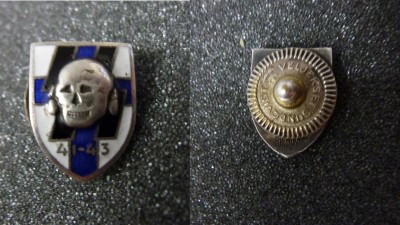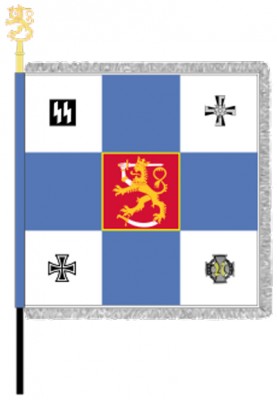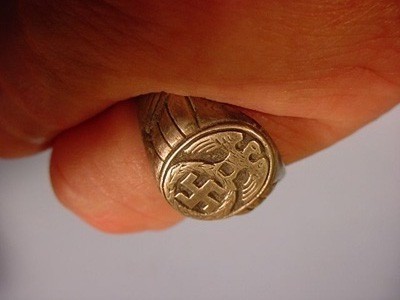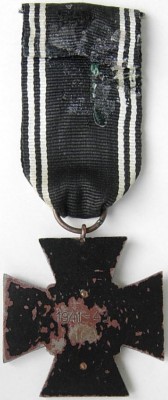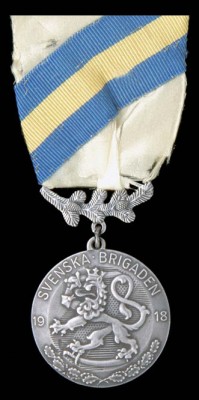This cross was intended to honour and reward the bravery of Finnish soldiers, volunteers serving in the German SS units (Viking Division and Nord Division).
The history of these soldiers, members of the SS units, begins in 1940 shortly after the end of the war waged against Finland by the Soviet Union.
The leading "recruiter" and personnel officer, and not only in Finland, was SS Obergruppenführer Gottlob Berger (1896-1975), who already in early 1941 had the first volunteers, veterans of the Winter War. Official negotiations with representatives of the Finnish government started on 22 February 1941.
With some problems, because the Finnish government was not very interested in sending volunteers to the SS units, the first 700 volunteers (Finns and Swedes) left Finland. The Germans even took advantage of the situation by recruiting workers to work in German industry, but they were essentially seasoned veterans of the 1939-1940 war who had reported to SS units in Germany. In this first phase, the Germans also guaranteed the transfer of Finnish ranks comparable to those of the SS troops.
On July 5, 1941, the last group of Finns left and after training were assigned to the SS Viking unit, which was somewhat disappointing for the Finns as they wanted to fight in a separate unit. At this point, the division commander Felix Steiner intervened and sensitively resolved the Finns' situation with a promise of further action acceptable to the Finnish soldiers. The Finns overcame the initial problems of the service, leaving for the Eastern Front where they fought bravely.
In addition to these volunteers, the German command also used instructors, Finns, veterans of the Winter War, to train their special units, who prepared the German soldiers well for war in the harsh winter conditions beyond the Arctic Circle.
By September 1941, the Finnish units are already listed and designated as the "Finnish Volunteer Battalion."
The SS units were strongly anti-religious, but in this case the German command relented and allowed the Finns to serve as field chaplains. The first chaplain was SS Untersturmführer Ensio Pihkala, who was killed. He was replaced by SS-Hauptsturmführer Kalervo Kurkiala.
The Finns signed a two-year service commitment. In 1943, the Finnish volunteers retreated back to their homeland. Besides, Marshal Mannerheim, who was the supreme commander of the Finnish army, expressed that he did not wish to replenish the SS forces with Finnish volunteers. The Germans, although reluctant, respected this wish.
The Finnish battalion had no military strength after the regrouping and the soldiers were assigned to Finnish Army units.
STATISTICS :
During the period 1941 - 1943 :
Finns killed : 222
Finns wounded : 557
After the armistice with the USSR, only a few soldiers remained in the SS units, fighting and leaving with the division soldiers from Finland.
Description of the cross :
The original of the cross is unknown to us. It is a type of Iron Cross in shape, with a golden eagle in its centre, the eagle's talons holding a swastika, in this case the Finnish swastika.
Note :
The Finnish government set three conditions for its volunteers, which the Germans accepted :
1. No volunteer would be forced to fight against Britain or Greece or in Africa. This also applied to other countries that were in a state of war with Germany, except for the USSR
2. No Finnish soldier would take an oath of allegiance to Adolf Hitler
3. If another Finnish-Russian war breaks out without German participation, Finnish soldiers will return home immediately
Literature :
Christopher. Ailsby : Hitler's renegades
D.A. Taras : War honors of Germany's allies. Minsk 2003
Zajímavý obrázek finských dobrovolníků SS. Obrázek je z roku 1942 , fronta u Leningradu ( dnes Sankť Petěrburg )
The history of these soldiers, members of the SS units, begins in 1940 shortly after the end of the war waged against Finland by the Soviet Union.
The leading "recruiter" and personnel officer, and not only in Finland, was SS Obergruppenführer Gottlob Berger (1896-1975), who already in early 1941 had the first volunteers, veterans of the Winter War. Official negotiations with representatives of the Finnish government started on 22 February 1941.
With some problems, because the Finnish government was not very interested in sending volunteers to the SS units, the first 700 volunteers (Finns and Swedes) left Finland. The Germans even took advantage of the situation by recruiting workers to work in German industry, but they were essentially seasoned veterans of the 1939-1940 war who had reported to SS units in Germany. In this first phase, the Germans also guaranteed the transfer of Finnish ranks comparable to those of the SS troops.
On July 5, 1941, the last group of Finns left and after training were assigned to the SS Viking unit, which was somewhat disappointing for the Finns as they wanted to fight in a separate unit. At this point, the division commander Felix Steiner intervened and sensitively resolved the Finns' situation with a promise of further action acceptable to the Finnish soldiers. The Finns overcame the initial problems of the service, leaving for the Eastern Front where they fought bravely.
In addition to these volunteers, the German command also used instructors, Finns, veterans of the Winter War, to train their special units, who prepared the German soldiers well for war in the harsh winter conditions beyond the Arctic Circle.
By September 1941, the Finnish units are already listed and designated as the "Finnish Volunteer Battalion."
The SS units were strongly anti-religious, but in this case the German command relented and allowed the Finns to serve as field chaplains. The first chaplain was SS Untersturmführer Ensio Pihkala, who was killed. He was replaced by SS-Hauptsturmführer Kalervo Kurkiala.
The Finns signed a two-year service commitment. In 1943, the Finnish volunteers retreated back to their homeland. Besides, Marshal Mannerheim, who was the supreme commander of the Finnish army, expressed that he did not wish to replenish the SS forces with Finnish volunteers. The Germans, although reluctant, respected this wish.
The Finnish battalion had no military strength after the regrouping and the soldiers were assigned to Finnish Army units.
STATISTICS :
During the period 1941 - 1943 :
Finns killed : 222
Finns wounded : 557
After the armistice with the USSR, only a few soldiers remained in the SS units, fighting and leaving with the division soldiers from Finland.
Description of the cross :
The original of the cross is unknown to us. It is a type of Iron Cross in shape, with a golden eagle in its centre, the eagle's talons holding a swastika, in this case the Finnish swastika.
Note :
The Finnish government set three conditions for its volunteers, which the Germans accepted :
1. No volunteer would be forced to fight against Britain or Greece or in Africa. This also applied to other countries that were in a state of war with Germany, except for the USSR
2. No Finnish soldier would take an oath of allegiance to Adolf Hitler
3. If another Finnish-Russian war breaks out without German participation, Finnish soldiers will return home immediately
Literature :
Christopher. Ailsby : Hitler's renegades
D.A. Taras : War honors of Germany's allies. Minsk 2003
Zajímavý obrázek finských dobrovolníků SS. Obrázek je z roku 1942 , fronta u Leningradu ( dnes Sankť Petěrburg )

